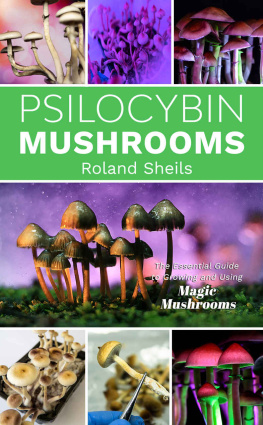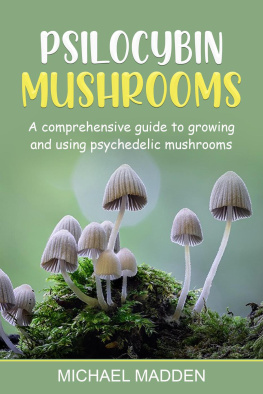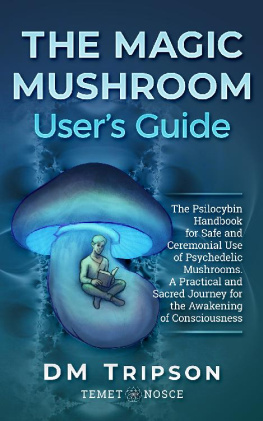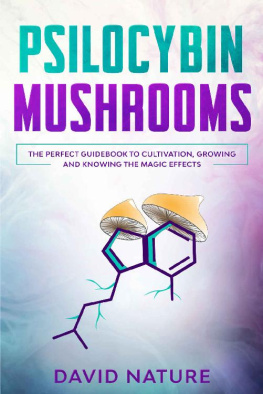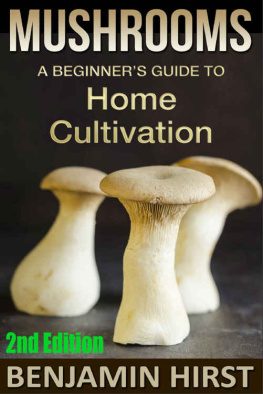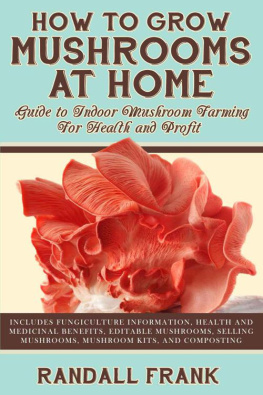Roland Sheils - PSILOCYBIN MUSHROOMS: The Essential Guide to Growing and Using Magic Mushrooms
Here you can read online Roland Sheils - PSILOCYBIN MUSHROOMS: The Essential Guide to Growing and Using Magic Mushrooms full text of the book (entire story) in english for free. Download pdf and epub, get meaning, cover and reviews about this ebook. year: 2020, genre: Romance novel. Description of the work, (preface) as well as reviews are available. Best literature library LitArk.com created for fans of good reading and offers a wide selection of genres:
Romance novel
Science fiction
Adventure
Detective
Science
History
Home and family
Prose
Art
Politics
Computer
Non-fiction
Religion
Business
Children
Humor
Choose a favorite category and find really read worthwhile books. Enjoy immersion in the world of imagination, feel the emotions of the characters or learn something new for yourself, make an fascinating discovery.
- Book:PSILOCYBIN MUSHROOMS: The Essential Guide to Growing and Using Magic Mushrooms
- Author:
- Genre:
- Year:2020
- Rating:3 / 5
- Favourites:Add to favourites
- Your mark:
- 60
- 1
- 2
- 3
- 4
- 5
PSILOCYBIN MUSHROOMS: The Essential Guide to Growing and Using Magic Mushrooms: summary, description and annotation
We offer to read an annotation, description, summary or preface (depends on what the author of the book "PSILOCYBIN MUSHROOMS: The Essential Guide to Growing and Using Magic Mushrooms" wrote himself). If you haven't found the necessary information about the book — write in the comments, we will try to find it.
Roland Sheils: author's other books
Who wrote PSILOCYBIN MUSHROOMS: The Essential Guide to Growing and Using Magic Mushrooms? Find out the surname, the name of the author of the book and a list of all author's works by series.
PSILOCYBIN MUSHROOMS: The Essential Guide to Growing and Using Magic Mushrooms — read online for free the complete book (whole text) full work
Below is the text of the book, divided by pages. System saving the place of the last page read, allows you to conveniently read the book "PSILOCYBIN MUSHROOMS: The Essential Guide to Growing and Using Magic Mushrooms" online for free, without having to search again every time where you left off. Put a bookmark, and you can go to the page where you finished reading at any time.
Font size:
Interval:
Bookmark:
PSILOCYBIN MUSHROOMS
The Essential Guide to Growing and Using Magic Mushrooms
Roland Sheils
Copyright 2020 By ROLAND SHEILS
All rights reserved.
This document is geared towards providing exact and reliable information with regard to the topic and issue covered. The publication is sold with the idea that the publisher is not required to render accounting, officially permitted or otherwise qualified services. If advice is necessary, legal or professional, a practiced individual in the profession should be ordered.
- From a Declaration of Principles which was accepted and approved equally by a Committee of the American Bar Association and a Committee of Publishers and Associations.
In no way is it legal to reproduce, duplicate, or transmit any part of this document in either electronic means or in printed format. Recording of this publication is strictly prohibited, and any storage of this document is not allowed unless with written permission from the publisher. All rights reserved.
The information provided herein is stated to be truthful and consistent, in that any liability, in terms of inattention or otherwise, by any usage or abuse of any policies, processes, or directions contained within is the solitary and utter responsibility of the recipient reader. Under no circumstances will any legal responsibility or blame be held against the publisher for any reparation, damages, or monetary loss due to the information herein, either directly or indirectly.
Respective authors own all copyrights not held by the publisher.
The information herein is offered for informational purposes solely and is universal as so. The presentation of the information is without a contract or any type of guarantee assurance.
The trademarks that are used are without any consent, and the publication of the trademark is without permission or backing by the trademark owner. All trademarks and brands within this book are for clarifying purposes only and are owned by the owners themselves, not affiliated with this document.
Table of Contents
There are rising numbers of people developing psilocybin mushrooms at home. Home cultivation eliminates the risk of misidentification of wild mushrooms in addition to a reliable supply throughout the year. It's also a fun, low-cost hobby for many growers.
You might be tempted to start with a psilocybin mushroom kit if you do not know how to grow mushrooms at home. These ready-to-use packages contain a living mycelium substrate (the material underlying the growth of the mushrooms) that you only have to keep moist in theory.
In fact, from scratch, you're better off. Making your own substrate is not only more coherent, but it should also be less contaminating if you do it correctly. There isn't a huge price difference, too, and you'll get to learn a lot more.
Psilocybin mushrooms are fungi containing the natural psychotic psilocybin compound, which is capable of producing intense hallucinations and spiritual encounters as well as other effects. More commonly referred to as "magical mushrooms" or "shrooms," psilocybin contains more than 180 species of mushrooms or its derivative psilocin. At the same time, fungi have a long history of spiritual and religious ritual use in Mesoamerica. These are also one of the most commonly used and popular psychedelics in the United States and Europe.
Nevertheless, psilocybin mushrooms are not only a drug and sacrament. They have been used in therapeutic environments to treat several ailments and disorders, including headache of clusters, obsessive-compulsive disorders, anxiety, depression, post-traumatic stress disorder, and dependence, and the recent resurgence in therapeutic effects of psilocybin showed promising results.
BIOLOGY OF MUSHROOMS
Let us imagine this situation, a cow paw on a grassy field on a dairy farm somewhere in the sun-drenched tropics. A single, magnificent specimen of Psilocybe cubensis stands at the top of this cow patty. His stalk is robust and feathery straight, and his cap is open, flat as a dinner plate. For the whole world, the cow patty seems to have somehow got a parasol to shade itself against the devastating effects of the sun. A black, dark, and almost infinite cloud of spores rains out of the darkness to locations unknown with any turning wind. However, keep this picture at the back of your mind as you read this chapter, which contains many things you need to know about mushroom biology.
This chapter includes a lot of complicated details and scientific jargon. You can only think of wading knowledge on the nature and biology of fungi. Then again, perhaps you are delighted to explore new fields of scientific knowledge. However, we ask you to help us, as knowing the fundamental processes in the mushroom life cycle can explain the cultivational techniques we present. When and when something doesn't suit the plan, this knowledge will allow you to understand what you see so that you can change your approach accordingly.
This chapter is about the elimination of misunderstandings as well as the introduction of new knowledge. That is because most of us believe we understand the mushrooms and how they work in the universe, and most of these ideas are false. When we first tried to grow mushrooms, we assumed we knew all about it, and our efforts were not quite spectacular. We only found success when we began to understand their mysteries.
What is a Mushroom?
Very few of us have anything to do with fungi, at least not with a choice. This is just like anything else, a cultural phenomenon. When most people believe in mushrooms, they picture the bland and harmless surfaces on their pizza or the exotic, ornate toads of a fairy tale and myth whose mere taste would drive a crazy person, if not kill him entirely. Mushrooms are fearful of poison or harmless vegetables for the vast majority of North Americans, and they do not deserve much thought. Even if you're in the tiny minority for which mushrooms provide fascination, wonder, and pleasure (probably due to one or more experiences with Psilocybe species), in your high school or college biology classes, you've probably learned little-by-little.
So, what is a mushroom exactly? A truffle is just one part of a fungus, not anything in itself, as you and your left elbow: w are related, but not the same. Strictly speaking, the reproductive structures of some mushrooms are roughly the same as the flowers of an apple tree, which contain "sowings" of future trees. Mushrooms are neither animal nor plant nor animal but are related to both. Not surprisingly, the correct classification of these elusive and hidden beings has always been subject to a lot of uncertainty. Most of us think of mushrooms and fungi as an odd variety of plants, often as they come from the ground like plants and seem incapable of walking (or dancing or swimming) as lucky animals can do. It is the most significant misunderstanding most of us have about fungi and the one you need to dispense with immediately. Here it is also: fungi are not plants, and developing mushrooms are not like gardening. Fungi are not animals either, although they are closer to animals than plants, given their appearances. Plants, algae, and certain bacteria synthesize their energy, carbon dioxide, and water and are known as autotrophs. All other organisms, including fungi, are heterotrophic, which means that they are derived from plants or food products (say, fish) or food items that eat plants (larger fish). However, this is almost where the similarities between animals and fungi end.
Classification and Taxonomy of Fungal
To order to understand how fungi fit into the "animal, vegetable and mineral" order, the more formal systems biology you use is to classify Y species, which are known as Linnaean taxonomical (the first Swedish botanist and physician to establish Carolus Linnaeus). Every single species has a specific Latin double (or binomial) name like Psilocybe basis or Homo sapiens in this framework. Such two names apply to the last two categories-genus and species-of an eight-part hierarchy organized by
Font size:
Interval:
Bookmark:
Similar books «PSILOCYBIN MUSHROOMS: The Essential Guide to Growing and Using Magic Mushrooms»
Look at similar books to PSILOCYBIN MUSHROOMS: The Essential Guide to Growing and Using Magic Mushrooms. We have selected literature similar in name and meaning in the hope of providing readers with more options to find new, interesting, not yet read works.
Discussion, reviews of the book PSILOCYBIN MUSHROOMS: The Essential Guide to Growing and Using Magic Mushrooms and just readers' own opinions. Leave your comments, write what you think about the work, its meaning or the main characters. Specify what exactly you liked and what you didn't like, and why you think so.

